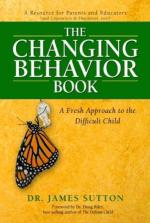Two Thoughts on Forgetting (Dr. James Sutton)
For young ones and older ones alike, “forgetting” can be a convenient way of dodging responsibility. But there’s one problem: We rarely forget things that are really important to us. Dr. James Sutton offers a handy tool for dealing with forgetting that just might be intentional.
……………………………………
 Everyone, children and adults alike, sometimes forget. Ongoing difficulty with remembering specific things, however, can be associated with anxiety or worry, or it can be a veiled form of defiant behavior, an undercover way of saying, “I didn’t WANT to!” Let’s take a look at both types of forgetting.
Everyone, children and adults alike, sometimes forget. Ongoing difficulty with remembering specific things, however, can be associated with anxiety or worry, or it can be a veiled form of defiant behavior, an undercover way of saying, “I didn’t WANT to!” Let’s take a look at both types of forgetting.
Thought #1: Forgetting That Causes Worry and Anxiety
What about the person who leaves for work or an extended trip only to worry later if they closed the garage door, unplugged the curling iron, or left the front door unlocked? And what about the youngster who realizes she left her overdue library book at home… again?
I recently went to some training on the treatment of anxiety disorders. While there, I picked up a little intervention that makes a lot of sense. It’s based on the fact that added cognitive impression at the moment of “storage” improves memory exponentially. Point: If you want to remember, make a “bigger” memory.
It’s simple, really. As you close the garage door say loudly, “I am now CLOSING the garage door!” Your neighbors might think you strange, but, even hours later, you will KNOW you closed that door. (And the same goes for unplugging the curling iron, feeding the cat, locking the front door or putting the library book in the school backpack with a flourished announcement.)
Thought #2: Passive-Aggressive Forgetting
Forgetting is a convenient way to say, without the risk of saying it, “I didn’t FEEL like doing that; so there!” Passive-aggressive adults can turn a workplace upside down with this behavior, while oppositional and defiant youngsters can brew up a ton of frustration in teachers and parents with forgetting. Then they wiggle off the hook with a less-than-sincere, “I’m sorry.”
 But, of course, nothing ever changes.
But, of course, nothing ever changes.
The solution to addressing intentional forgetting is to attack the intention. So, the next time you give the child or student an instruction or direction to be completed later, ask them this question (and try to do it with a straight face):
Do you think that is something you’ll forget?
(Regardless of the look on their face, it’s my guess the question will catch them off-guard. If they stammer a bit, it’s probably because they KNOW they’ve stepped into a bit of quicksand.)
For them to say, “Yes,” would be to expose more of their intent that they generally care to show. (But if that’s what they say, my next step would be to ask them to come up with a strategy for remembering, and then hold out until I get it from them.)
In most cases, the youngster will say, “No,” just to end the conversation. Then, if they DO forget, you’ve created a perfect opportunity to remind them what they told you earlier. The youngster essentially verifies the need for the question with his or her behavior.
Since these kids don’t really like to give adults the upper hand at their expense, you just might have a different outcome when you ask the same question (“Do you think that’s something you’ll forget?) next time. ###
A semi-retired child and adolescent psychologist, author and speaker, Dr. James Sutton is the founder and host of The Changing Behavior Network. For more tried-and-true strategies for reaching and working with difficult children and teens, consider downloading his book, 60 Ways to Reach a Difficult and Defiant Child. CLICK HERE for more information.
 This blog, It’s About Them, was founded in 2006 by child and adolescent psychologist, Dr. James Sutton. Content will vary, but the message here promotes courage, kindness, vision and the powers of the human spirit in ourselves and our children. Dr. Sutton can be reached at
This blog, It’s About Them, was founded in 2006 by child and adolescent psychologist, Dr. James Sutton. Content will vary, but the message here promotes courage, kindness, vision and the powers of the human spirit in ourselves and our children. Dr. Sutton can be reached at 








